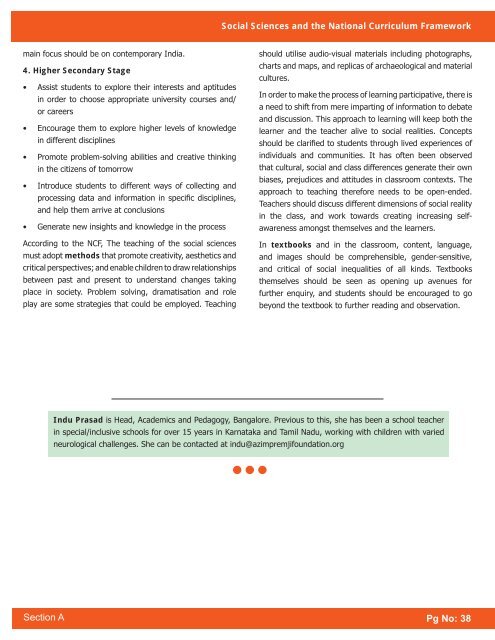Indesign Pagesnew.indd - Azim Premji Foundation
Indesign Pagesnew.indd - Azim Premji Foundation
Indesign Pagesnew.indd - Azim Premji Foundation
Create successful ePaper yourself
Turn your PDF publications into a flip-book with our unique Google optimized e-Paper software.
main focus should be on contemporary India.<br />
4. Higher Secondary Stage<br />
•<br />
•<br />
•<br />
•<br />
•<br />
Assist students to explore their interests and aptitudes<br />
in order to choose appropriate university courses and/<br />
or careers<br />
Encourage them to explore higher levels of knowledge<br />
in different disciplines<br />
Promote problem-solving abilities and creative thinking<br />
in the citizens of tomorrow<br />
Introduce students to different ways of collecting and<br />
processing data and information in specifi c disciplines,<br />
and help them arrive at conclusions<br />
Generate new insights and knowledge in the process<br />
According to the NCF, The teaching of the social sciences<br />
must adopt methods that promote creativity, aesthetics and<br />
critical perspectives; and enable children to draw relationships<br />
between past and present to understand changes taking<br />
place in society. Problem solving, dramatisation and role<br />
play are some strategies that could be employed. Teaching<br />
Section A<br />
Social Sciences and the National Curriculum Framework<br />
should utilise audio-visual materials including photographs,<br />
charts and maps, and replicas of archaeological and material<br />
cultures.<br />
In order to make the process of learning participative, there is<br />
a need to shift from mere imparting of information to debate<br />
and discussion. This approach to learning will keep both the<br />
learner and the teacher alive to social realities. Concepts<br />
should be clarifi ed to students through lived experiences of<br />
individuals and communities. It has often been observed<br />
that cultural, social and class differences generate their own<br />
biases, prejudices and attitudes in classroom contexts. The<br />
approach to teaching therefore needs to be open-ended.<br />
Teachers should discuss different dimensions of social reality<br />
in the class, and work towards creating increasing selfawareness<br />
amongst themselves and the learners.<br />
In textbooks and in the classroom, content, language,<br />
and images should be comprehensible, gender-sensitive,<br />
and critical of social inequalities of all kinds. Textbooks<br />
themselves should be seen as opening up avenues for<br />
further enquiry, and students should be encouraged to go<br />
beyond the textbook to further reading and observation.<br />
Indu Prasad is Head, Academics and Pedagogy, Bangalore. Previous to this, she has been a school teacher<br />
in special/inclusive schools for over 15 years in Karnataka and Tamil Nadu, working with children with varied<br />
neurological challenges. She can be contacted at indu@azimpremjifoundation.org<br />
Pg No: 38

















